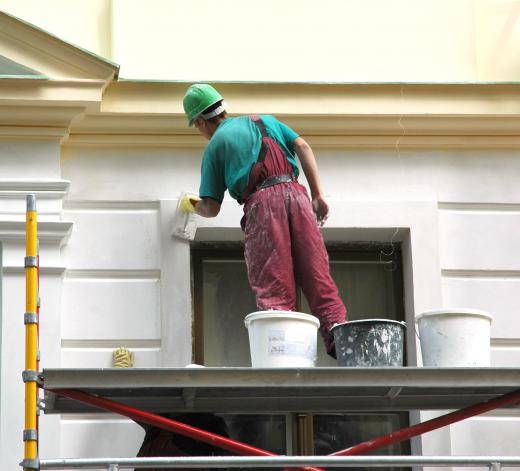Painter's tape is a type of adhesive tape which is designed for use in painting. This tape is used to mask during painting jobs to keep the lines of the job crisp and clean while protecting windows, woodwork, and other areas from smeared or spilled paint. Using painter's tape is very important when painting, to ensure that the finished product looks neat and clean. Most hardware and home supply stores stock painter's tape, and several different kinds are available.
This tape is often blue in color, and it has a light adhesive which is designed to cling without becoming firmly attached, so that the tape can be removed at the end of a paint job without causing damage. Companies which make painter's tape usually make several grades of adhesive which are designed for different surfaces. Consumers need to be aware of this so that they pick the right tape for the job; most packages detail the types of surfaces the paint is designed to be used on.

There are a few tips to keep in mind when working with painter's tape. The first is that the tape should always be tested on the surface first. This is done by cutting off a small piece of tape and sticking it to the surface it will be masking, to see if it has the appropriate level of adhesion. If the tape does not stick, it is too weak, and if the tape pulls off finish or paint, the adhesive is too strong.
Once painters have determined that they have the right tape for the job, they can apply the tape to the edges of surfaces they want to protect. The surfaces should be wiped down so that they are clean and smooth, and they should be completely dry. It is important to avoid stretching the tape, with painters instead cutting off long strips and gently smoothing them so that they adhere to the surface. This leaves some give in the tape so that if it shrinks, it will not crack or bubble.
After the painting is finished, the paint should be allowed to dry completely before the tape is removed. Painter's tape can be slowly and gently torn off. Ripping the tape rapidly is not advised, as this can cause some of the paint to come up with the tape. Painter's tape is not reusable, and it should be discarded after it has been removed.
Ever since she began contributing to the site several years ago, Mary has embraced the exciting challenge of being a About Mechanics researcher and writer. Mary has a liberal arts degree from Goddard College and spends her free time reading, cooking, and exploring the great outdoors.

